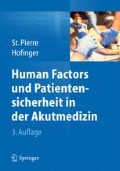Zusammenfassung
In diesem Kapitel geht es um die Struktur von und den (psycho-kognitiven) Weg zur Entscheidung: Eine gute Entscheidung in der Akutmedizin bewirkt, dass man den Anforderungen der Notfallsituation gerecht wird. Dabei können bestimmte Strategien und Entscheidungsketten helfen, um die es in diesem Kapitel gehen soll. Eine gute Strategie beinhaltet z. B. fünf wesentliche Schritte: Vorbereitet sein, die Situation analysieren, Ziele festlegen und Pläne entwerfen, Strategien umsetzen, Ergebnis überprüfen. Ferner zeichnet eine gute Strategie aus, dass Sie möglichst „mehrere Türen offen“ lässt. Entscheidungshilfen (z. B. DECIDE, FOR-DEC) ermöglichen es, Entscheidungsprozesse anhand einer Regel zu strukturieren und „durchzubuchstabieren“. Der große Vorteil dieser Entscheidungshilfen besteht darin, dass alle Teammitglieder die gleichen Ansätze im Entscheiden und Handeln teilen.
Access this chapter
Tax calculation will be finalised at checkout
Purchases are for personal use only
Literatur
Benner L (1975) D.E.C.I.D.E. in hazardous materials emergencies. Fire Journal 69:13–18
Block AJ (1993) Beware of the VIP syndrome. Chest 104:989
Croskerry P (2009a) Context is everything or how could I have been that stupid? Healthcare Quarterly 12, e171–e177
Croskerry P (2009b) A universal model of diagnostic reasoning. Acad Med 84:8, 1022–28
Dörner D (1989) Die Logik des Misslingens. Rowohlt, Reinbek bei Hamburg
Dörner D, Schaub H (1995) Handeln in Unbestimmtheit und Komplexität. Organisationsentwicklung 14: 34–47
Dreyfus HL, Dreyfus SE (2000) Mind over machine: The power of human intuition and expertise in the era of the computer (5 Auflage). Blackwell, Oxford
Evans JSBT (2003) In two minds: dual-process accounts of reasoning. Trends in cognitive sciences 7(10), 454–59
Evans JSBT (2008) Dual-processing accounts of reasoning, judgment and social cognition. Annu Rev Psychol 59:255–78
Evans J S B T, Stanovich KE (2013) Dual-process theories of higher cognition: advancing the debate. Perspectives on Psych Sci 8:3; 223–41
Gaba D (1992) Dynamic decision–making in anesthesiology: cognitive models and training approaches. In: Evans DA, Patel VL (eds) Advanced models of cognition for medical training and practice. Springer, Heidelberg, pp 123–148
Gigerenzer G (2008) Bauchentscheidungen: Die Intelligenz des Unbewussten und die Macht der Intuition. C. Bertelsmann Verlag, New York
Gladwell M (2007) Blink-Die Macht des Moments. Piper
Graber ML, Kissam S, Payne VL, Meyer AND, Sorensen A, Lenfestey N, Tant, E, Henriksen K, LaBresh K, Sing H (2012) Cognitive Interventions to reduce diagnostic error: a narrative review. BMJ Qual Saf 21:535–57
Hoermann HJ (1995) FOR-DEC. A prescriptive model for aeronautical decision-making. In: Fuller R, Johnston N, McDonald N (eds) Human factors in aviation operations. Proc of the 21st Conference of the European Association for Aviation psychology (EAAP), vol 3, Avebury Aviation, Aldershot Hampshire, pp 17–23
Hofinger G, Proske S, Steinhardt G, Sol, H (2014) FORDEC et al. - Entscheidungsmodelle in der Luftfahrt. In: Schaub H, Strohschneider S, Heimann R (Hg.) Entscheiden in kritischen Situation – Umgang mit Unbestimmtheit. Verlag für Polizeiwissenschaft, Frankfurt a.M., 119–137
Jensen RS (1995) Pilot judgement and crew resource management. Ashgate Publishing, Vermont USA
Kahnemann D (2012) Schnelles Denken, langsames Denken. Siedler Verlag, München
Klein G (1998) Sources of Power: How People Make Decisions. Cambridge, MA: The MIT Press
Murray WB, Foster PA (2000) Crisis resource management among strangers: principles of organizing a multidisciplinary group for crisis resource management. J Clin Anesth 12: 633–8
Oesterreich R (1981) Handlungsregulation und Kontrolle. Urban & Schwarzenberg, München
Orasanu J, Connolly T (1992) The reinvention of decision making. In: Klein G, Orasanu J, Calderwood R, Zsamboka E (eds) Decision making in action: models and methods. Ablex Publishing, New Jersey, pp 3–20
Reason J (1994) Menschliches Versagen. Spektrum, Heidelberg
Risser DT, Rice MM, Salisbury ML, Simon R, Jay GD, Berns SD (1999) The potential for improved teamwork to reduce medical errors in the emergency department. The MedTeams Research Consortium. Ann Emerg Med 34: 373–83
Runciman WB (1988) Crisis management. Anaesth Intensive Care 16: 86–8
Small SD, Wuerz RC, Simon R, Shapiro N, Conn A, Setnik G (1999) Demonstration of high-fidelity simulation team training for emergency medicine. Acad Emerg Med 6: 312–23
Saxton R, Hines T, Enriquez M (2009) The negative impact of nurse-physician disruptive behavior on patient safety: a review of the literature. J Patient Saf 5:3; 180–3
Stiegler MP, Tung A (2014) Cognitive processes in anesthesiology decision making. Anesthesiology 120:204–17
Trowbridge RL (2003) Twelve tips for teaching avoidance of diagnostic errors. Med Teach 30:496–500
Author information
Authors and Affiliations
Corresponding author
Rights and permissions
Copyright information
© 2014 Springer-Verlag Berlin Heidelberg
About this chapter
Cite this chapter
St.Pierre, M., Hofinger, G. (2014). Handlungsstrategien: Wege zur guten Entscheidung. In: Human Factors und Patientensicherheit in der Akutmedizin. Springer, Berlin, Heidelberg. https://doi.org/10.1007/978-3-642-55420-9_10
Download citation
DOI: https://doi.org/10.1007/978-3-642-55420-9_10
Published:
Publisher Name: Springer, Berlin, Heidelberg
Print ISBN: 978-3-642-55419-3
Online ISBN: 978-3-642-55420-9
eBook Packages: Medicine (German Language)

